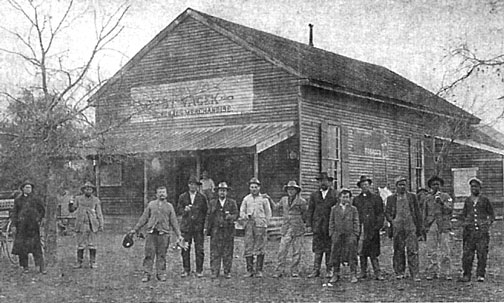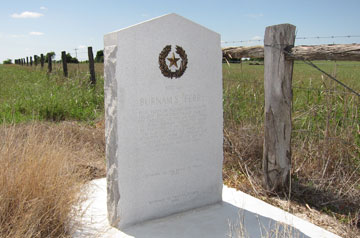Holman, Texas—Looking Back
Staches Vacek General Merchandise Store, circa 1902-1905.
Rural Fayette County is noted for its many distinctly ethnic communities. The mailboxes and county road signs reflect the Central European heritage of the descendants of Moravians, Bohemians, Germans and German-Moravians, who began emigrating to this area in the mid-1850s. Most of the small towns disappeared from Texas maps years ago, but their heritage lives on with the families that still live in the rural environs settled by their immigrant ancestors.
Holman, Texas is one of these communities. Located in Holman Valley, it is picturesquely situated on Pecan Creek, about thirteen miles southwest of La Grange on FM 155, two miles away from the Colorado River. The country is very rich and fertile black land prairie, which was attractive to the early American settlers, who owned large cotton plantations that were worked by slaves.
One of the first settlers in the area was Jesse Burnham, a member of Austin’s “Old Three Hundred”, who received a league of land south of the Colorado River in 1824. He moved his family there in 1834 and built a house, store and ferry. He was one of the first to raise cotton in Fayette County shortly after he established his homestead. In 1836, Sam Houston’s Army crossed the Colorado River at Burnham’s Crossing during the “Runaway Scrape”, after which Houston ordered the sinking of Jesse Burnham’s ferry and the burning of his store and home to prevent Santa Anna’s army from using the property and supplies, causing the old Indian fighter a considerable loss.
In 1844, George and John Holman purchased 457 acres from Burnham and eventually acquired a total of approximately 4000 acres for a cotton plantation, naming their holdings Holman Valley. The deed for the Holmans’ land acquisition from Burnham designates that a cemetery had already been established on Burnham’s land; it eventually became a burial place for the Holman family as well. Burnham then moved 3.5 miles down the river where he established a new place called Burnham’s Station. Both George and John Holman married daughters of Jesse Burnham. They built a two-story eight-room southern, manor-type house on the site of Burnham’s home that was burned, and it is believed that both families lived there together.
Additional settlers arrived, including G.W. Lewis, J.H. McKinley, Thomas Slack, Thomas Hubbard, William T. Roberts, John Smith and Lott Fisher. After the Civil War and the collapse of the large farm and plantation system, Germans and Czechs, who were eager to purchase good farm land, also began settling in the area. Some of the families were the Osinas, Seydlers, Hajovskys, Vaceks, Mazochs, Salases, Brandts, Bittners, Cernoseks and Hluchaneks. They purchased smaller farms, on which they mostly grew cotton until the 1950s; now most of the farmers grow corn or grasses for hay, or harvest pecans that thrive in the area. More recently, the dredging for sand and gravel has dramatically altered the appearance of the valley. Massive holes and piles of earth have created unsightly pockmarks in what was once productive farm land.
The community at one time was called Pecan, named after the creek that runs through the area. The creek takes its name from the great number of pecan trees that line it. The first store was Thomas Slack’s Variety Store built in the summer of 1880. Slack sold it five years later to Bennett Holman; it later became the German Public School until 1918, when a new public school was constructed. The building was then used as the Hermann Sons Lodge until it became too dilapidated and could only be used for storing hay.
The Holman Store had its beginning as the Cumberland Presbyterian Church, which was established in 1873. George Lewis purchased the property in 1892 and converted the building into a general store. Lewis, who was appointed postmaster in 1892, had the post office in his store. He changed the name of Pecan to Holman after his wife Amanda Roberts Holman, the widow of Henry C. Holman. In 1902, Lewis sold the store and four acres to Eustach “Staches” Vacek, who served as postmaster for five years until a rural mail route was established to Holman from Weimar. Vacek added a saloon and pool hall, followed by a dance hall on the western end of the building. He also built a liquor store next door and operated an adjacent molasses press. In 1915, Vacek sold the store complex to his son, Frank J. Vacek, who took a partner, Frank Miksch. They called their establishment the Vacek-Miksch Holman General Merchandise Store. Since cars were becoming popular, they began selling Texaco gasoline – the pumps and tank were still there until the 1980s. The store remained in the Vacek family until 1987, when it was sold to David and Judy Hajovsky, who converted the store and saloon into the Holman Valley Steak House, where patrons can enjoy a bit of history along with their meals. The old dance hall with lacy filaments of spider webs covering its walls held its last dance in the 1960s and is now used for storage.
Eventually more businesses were added to serve the needs of the early-day settlers. In addition to the above mentioned businesses, there were three blacksmith shops, a wheelwright shop and a cotton gin. The first gin was built by Thomas Slack in 1882 across from the George Lewis store. It went through several ownerships and was last owned by the Mazoch family. Jimmy Mazoch operated it until 1955, when cotton planting in the area declined, and modernization provided too much competition.
The first public school in the area was the Pecan Creek Male and Female Academy, circa 1871, built approximately six-tenths of a mile west of the Holman Store. After the Czechs arrived in the 1880s, it was called the “Orech School”, the Czech name for “Pecan School”. The original school building survived until 1923, when a new school was built. The Pecan School closed in 1947 when the rural schools in the county were consolidated, and children were bussed to La Grange.
A new Holman Public School, constructed opposite the St. Wenceslaus Catholic Church in 1918, also served the community well until the consolidation of schools. Then the Pecan School was moved adjacent to the Holman Public School, creating a Catholic parish hall, which stood until 1981, when a new parish hall was erected.
St. Wenceslaus Catholic Church was established at Holman in 1918. Prior to that time, the Catholic settlers had to travel to nearby churches, first by ferry across the river to the church at Live Oak Hill near Ellinger, and then to Dubina or Ammannsville. The five-acre site for the church and cemetery was donated by Staches and Frantiska Vacek.
The recently-renovated church was completely destroyed by fire in 1964. The fire, which totally engulfed the structure by the time firemen from three towns arrived, was so hot that the brass bell melted. Undaunted, the parishioners were able to build a new brick church, which was dedicated in December, 1967.
The church, cemetery, parish hall and Holman Valley Steakhouse are all that remain of a once-thriving community. Now the silence of the countryside is broken by an occasional car traveling through on FM 155, or the distant hum of a giant, modern-day tractor plowing the fields that have provided sustenance for generations of families living in beautiful Holman Valley.



